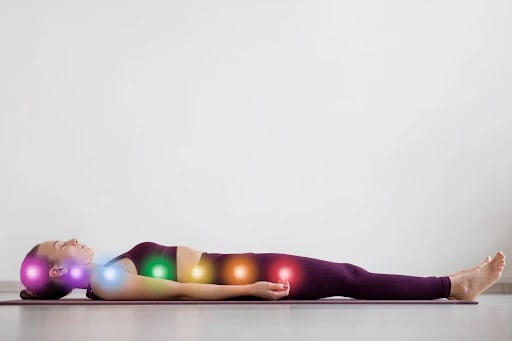Click here for Yoga Retreat NEPAL
Yoga Nidra
Yoga nidra is a practice that can be extensively utilized in contemporary society to enhance the quality and joy of human existence. This technique is both straightforward and deeply impactful, finding application in various domains:
Kaushalendra Thakur
7/1/20256 min read


Yoga nidra is a practice that can be extensively utilized in contemporary society to enhance the quality and joy of human existence. This technique is both straightforward and deeply impactful, finding application in various domains:
1. Relaxation: Yoga nidra serves as the most effective, economical, and enduring method for achieving profound relaxation throughout the entire human being and personality.
2. Meditation: It functions as a meditative practice.
3. Psychological issues: Yoga nidra directly addresses and helps eliminate deeply ingrained psychological complexes, advanced neuroses, and inhibitions, making it a valuable psychiatric tool.
4. Psychosomatic disorders: This practice aids in alleviating numerous ailments primarily rooted in mental causes, such as hypertension.
5. Sleep: Yoga nidra promotes and enhances deep sleep, acting as a non-chemical tranquilizer that swiftly alleviates insomnia.
6. Comprehensive rejuvenation of the human organism can be achieved through yoga nidra, recharging the physical, pranic, and mental aspects of an individual.
7. Exploration and awakening of the mind: Yoga nidra unlocks the mind's potential and stimulates the intuitive faculties.
8. Learning, education, and intelligence: This practice is a significant educational resource currently being researched and tested globally. It has demonstrated remarkable improvements in both the absorption and retention of external information, as well as in accessing knowledge within one's own mind, thereby enhancing intelligence in all its forms.
Yoga nidra possesses a multitude of additional applications, serving as a remedy for the stress-laden world of today.
Definition
Yoga refers to the inner communion and the process that facilitates this state. Nidra translates to sleep. Therefore, yoga nidra can be described as 'yogic sleep.' It encompasses both a specific yogic practice and a distinct state of being. While the mechanics of the practice are straightforward and easily defined, the experience of yoga nidra varies among individuals, as outlined below:
Sleep: For an individual who is fatigued, overwhelmed, and perpetually anxious, the experience of yoga nidra may simply equate to a profound and rejuvenating sleep. This is a common motivation for many who engage in yoga nidra, whether independently or in classes, seeking merely to drift into a state of slumber. There is nothing inherently wrong with this approach, as deep sleep offers numerous benefits. In yoga nidra sessions, participants are typically encouraged to maintain wakefulness; however, if this proves challenging, one should not be concerned—embracing sleep is perfectly acceptable. In the future, one may choose to attempt remaining awake.
Psychic sleep: For others, particularly those with several years of yoga practice, yoga nidra may represent a state of conscious dreaming, wherein individuals experience visions from their subconscious. In this state, one may find themselves suspended between sleep and wakefulness, confronting subconscious issues, repressed emotions, and fears. Consistent practice can gradually cleanse and refine the mind.
Sleepless sleep: This is regarded as the pinnacle of yoga nidra, where one achieves a delicate balance between introversion and extroversion.
The sushumna pathway is associated with the awakening of kundalini energy. This pathway leads to a profound and transcendent state of 'yoga,' which aligns with superconsciousness. Throughout history, countless yogis, saints, devotees, and sages have articulated this experience. In the esteemed yogic text, Yogataravali, Shankaracharya states:
"When sankalpa (intentions) and vikalpas (thoughts and fantasies) are eradicated, one becomes free from the influence of karma. Through persistent yogic practice, when sankalpa and vikalpa are eliminated, the ever-joyful state of yoga nidra emerges."
We have identified three distinct states of yoga nidra. As a practice, it can be characterized as a technique for achieving physical and nervous calmness, a means to alleviate chronic mental tension, and a method for fostering inner awareness and meditation. It transcends rational thought processes and cultivates inner tranquility.
The Layers of the Mind
Yoga nidra serves as a technique for delving into the various layers of the mind. Certain contemporary psychological frameworks identify three dimensions of the mind: the conscious, subconscious, and unconscious. Similarly, the Mandukya Upanishad categorizes the mind into three layers: jagrat, swapna, and sushupti. The correlation between yogic and psychological terminology can be outlined as follows:
jagrat:
- conscious mind in the waking state
- surface thoughts and perceptions of the external environment
- sthula (gross dimension)
swapna:
- subconscious mind
- dream state
- individual memory and mind
- sukshma (subtle dimension)
sushupti:
- unconscious mind
- deep conscious sleep state
- memory
- karana (causal dimension)
Yoga nidra initiates from the swapna state, focusing on the exploration of the subconscious mind. Mastery of yoga nidra can lead to a deeper level of perception, allowing individuals to access and investigate the sushupti or cosmic mind. Advanced practitioners, or great yogis, may transcend the mind altogether, entering a state of superconsciousness. In the Mandukya Upanishad, this state is referred to as turiya (the fourth dimension of existence). This represents the pinnacle of yoga nidra, a state achieved by only a select few. The Yogataravali states:
"Beyond these three states (jagrat, swapna, and sushupti) lies turiya. It is a state that yogis experience spontaneously. It embodies true yoga nidra in the form of pure, illuminated consciousness."
Nyasa - Traditional Yoga Nidra
The term "nyasa" translates to 'to place.' This practice involves the placement and sensation of specific mantras at various locations on the body. It represents the traditional approach to yoga nidra that has been utilized by yogis throughout history and continues to be embraced by nearly all Hindus today.
Nyasa is referenced in numerous texts, including the Brihad Yoga Yagyavalkya Smriti and the Yogataravali, along with various Upanishadic and Tantric writings. The Aruneyi Upanishad (verse 5) encourages all wandering sannyasins to consistently engage in nyasa, which involves mentally placing and chanting AUM at different body parts. More detailed and ritualistic variations of nyasa are outlined in the Maha-nirvana Tantra, which includes the following practices:
Matrika nyasa, where the letters of the Sanskrit alphabet (matrikas) are positioned on distinct areas of the sadhaka's physical body while the corresponding sounds are chanted.
Hridayadi sadanga nyasa, which literally refers to the placement of hands on six specific parts (sadanga) of the body, starting with the heart (hridaya). Specific mantras are recited during this practice: "namah" when touching the heart, "swaha" when touching the head, "vasat" at the crown lock, and so forth.
Kara nyasa involves the placement and chanting of mantras on the fingers, thumbs, and palms of the hands. (It is noteworthy that most yoga nidra practices we teach incorporate this type of nyasa, albeit without the accompanying mantras).
Vyapaka nyasa, or all-pervasive nyasa, derives its name from the distribution of the mantra's energy throughout the entire body, accompanied by heightened awareness. Specific mantras are placed and experienced on the head, mouth, heart, and other areas.
The Framework of Practice
Yoga nidra can be categorized into the following segments:
1. Initial adjustment of the body
2. Initial relaxation of the physical body
3. Initial relaxation of the mind
4. Sankalpa (intention)
5. Rotation of awareness across various body parts
6. Visualization
7. Reflection and awareness of symbols
8. Sankalpa
9. Reconnection with external awareness
These nine stages are to be followed in a sequential manner, adhering to the specified order. Modifications may be incorporated within this fundamental structure.
Practice
To maximize the benefits of yoga nidra, it is essential to adhere to the following guidelines and preparations:
Attire: It is advisable to eliminate any tight or uncomfortable clothing. Opt for loose, lightweight garments, as minimal clothing is preferable, particularly in warm climates. Conversely, in cooler environments, ensure you wear enough layers to stay warm throughout the session, or consider using a warm blanket for added comfort.
Insect Precautions: If you are in an area with insects such as mosquitoes or flies, it is recommended to practice under a mosquito net or to cover yourself with a light sheet to avoid disturbances.
Temperature Control: In excessively hot conditions, you may use a fan, provided it operates quietly. Avoid direct airflow on your body. Utilize a fan only if absolutely necessary; otherwise, it is best to refrain from its use.
Setting: Choose a quiet, dimly lit, and well-ventilated space for your practice. Avoid environments with harsh lighting, unpleasant odors, dusty air, or frequent interruptions. While outdoor settings may seem appealing, it is generally advisable to practice yoga nidra indoors.
Removal of Accessories: Prior to commencing yoga nidra, take off your wristwatch, glasses, jewelry, and any other adornments.
Preparation Exercises: Since yoga nidra requires you to maintain a single position for an extended duration, it is important to ensure your body is relaxed and flexible. If needed, consider performing a few asanas beforehand, such as naukasana and surya namaskara, to alleviate stiffness.
Adjustment of the body: Prior to initiating yoga nidra, it is essential to address any physical discomfort or restlessness. Engaging in movement before the practice is preferable to doing so during it. If you experience any skin irritation, feel free to scratch the affected area. Additionally, if your attire is uncomfortable, make the necessary adjustments. Ensure that you are completely at ease before beginning yoga nidra. The time invested in these preparations will be well worth it, as it will enhance the benefits of your subsequent practice.
Timing of practice: Yoga nidra can be practiced at any time, day or night, but it is advisable to avoid doing so immediately after meals; a waiting period of about an hour is recommended. It is best to practice when you are feeling physically or mentally fatigued. For those experiencing insomnia or disrupted sleep patterns, practicing yoga nidra in bed at night can be particularly beneficial.
Posture
In yoga nidra, the physical posture should be so comfortable that one becomes unaware of the body, perceiving it merely as a 'shell' or 'husk' of the mind. It is essential to select a position that can be sustained without movement for a duration of 10 to 60 minutes. While various poses may be suitable for this practice, our experience indicates that the shavasana (corpse pose) is the most effective.
Begin by placing a blanket on a flat, even surface.
Lie down flat on your back.
If desired, a thin pillow may be positioned under the back of the head, ensuring it is not overly thick. The head, arms, and legs should be aligned in a straight line, with the palms facing upwards.
Close your eyes.
Once all preparatory physical adjustments have been made and the urge to move has subsided, allow the entire body to relax. At this juncture, yoga nidra can commence.
Sankhya Yoga & Wellness
Heal . Connect . Transform
Experience tranquility and rejuvenation through yoga.
Contact us
info@sankhyayogawellness.com
+91-8094250516/+91 9322447704
© 2025 Sankhya Health LLP. All rights reserved.
